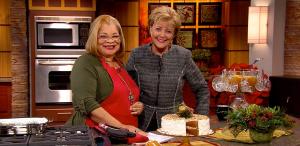Dr. Linda Mintle: Don't Just Eat, Stop and Think
CBN.com LEARNING FROM THE MOMENT
Linda’s professional life has been focused on developing strategies that work when it comes to food and living a healthy lifestyle. For the last six years, Linda has appeared on ABC Family’s Living the Life television show as Dr. Linda.
“I am often reminded that you don’t need to be in therapy to have issues with food,” she says.
Many of us eat when we are not hungry, eat without thinking or overeat when we are full.
“Once we eat to our own regret, then our sense of defeat only leads to more overeating,” says Linda.
To make matters worse, after we have eaten something we don’t really want or need, we usually give in to the hopelessness of the moment, rather than tell ourselves to let it go and move on. “What we need to do is learn from the moment,” says Linda.
One day Linda was sitting with her friend, Suzy, in a coffee shop. Suzy bought a pastry with her coffee and started eating it while talking to Linda. After she was done, Suzy was remorseful about consuming the pastry. She told Linda that she always eats when she’s not hungry. Linda told her to learn to press a mental pause button and become more aware of her eating.
“Pressing pause is more than a strategy,” says Linda. “It is a mindset that has been the foundation of my work with clients in theraby for more than 25 years.”
The basic Pause Principle is this:
- Purpose in your heart to pause
- Attend to the moment
- Understand why and what you do
- Strategize ways to make changes
- Execute new ways to think, feel and act
SATISFYING HUNGER
We must understand that eating is more than a physical act that satisfies hunger. We eat when we fight with a spouse, are stressed by the demands of elderly parents or screaming toddlers. Food gives us pleasure and a momentary break. Linda says we also eat to satisfy a spiritual hunger.
“There is a natural emptiness in all of us that can’t be met through the natural appetite,” says Linda.
Food cravings are linked to the brain and hormones. Many times we eat due to an emptiness that has nothing to do with food. The problem is that Linda says we don’t always recognize this craving and we often mistake it for other things. To fulfill this hunger, we look not only to food but other people and things.
Linda has discovered working in the delivery of health and wellness to people that most everything is Buddhist and influenced by eastern religion.
“These approaches have spread in the holistic health movement like wild fire,” says Linda. Every week she receives brochures and training offers in psychology that incorporate spirituality. “The spirituality being taught is clearly eastern religion with New Age approaches,” she says.
At a recent conference for therapy for borderline personality disorders, the training began with Densho Bell and Buddhist meditation. “No one was given an option,” says Linda. “While I am constantly asked to be tolerant of the spirituality of others, Christianity is not allowed a voice.”
Linda feels her message is an important voice in the mindfulness movement. “It is a lone voice and needs a place at the mindfulness table,” she says. “So much of food and weight problems stem from the way we think and manage our emotional, relational and spiritual lives. Instead of offering Buddhist meditation that empties the mind, I offer the perspective of filling your mind with Christ.” Her hope is to get this book in the hands of those seeking help through mindful approaches.





